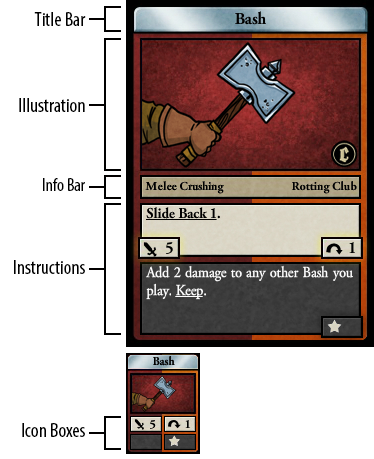Cards
You want Cards.
You need Cards.
Cards are power.
Cards will bring you glory.
That's why you're a Card Hunter.
Every ability your party has, every action you take, every sword swung and every spell cast...
... is on a card.
You literally won't get anywhere without using your cards. Movement is on a card, too.
Cards are the basic unit of the Card Hunter combat game. When it's your turn, you get to play one of the cards that your adventurers have drawn out of a deck that represents their entire stock of abilities, strengths, and weaknesses. Yes, some of your own cards can actually do bad things to you while your opponent chortles. But that will only make your eventual triumph all the more sweet. You are planning to win, aren't you?
Contents |
Card Origins
- see also: Category:Items
Each of your characters has a deck of 36 cards, plus a special one called the Default Move Card. For a party of three, that's a total of 111 cards to play with. (In the very early game for new players, while some game mechanics are being introduced, your characters may have fewer cards than that. But they grow up fast.) How do you get all those cards? Cards come from the Category:Items that your characters equip: each item bestows certain abilities that translate into cards for your deck. For example, the item known as Bloodfoot Wand includes two copies of the Stone Spikes card and one copy of Gusts of War. Those three cards are shuffled along with the other 33 cards, and if you draw Stone Spikes or Improved Telekinesis during play you will have an opportunity to cast a powerful magic spell. If your luck is such that you don't draw the cards, then you can't use the abilities of your Bloodfoot Wand. Of course, equipping other items can give you very different cards instead.
Using no items at all will result in a deck full of "default" cards, representing the sort of abilities that you have if you go into battle without any weapons and not wearing any armor. Those are some shameful, weak cards. But it does mean that you never need to worry about counting to see whether you have a legal deck size. By equipping any item onto your character, you substitute that item's associated cards for an equal number of cards you will no longer be using, and the total size of your deck doesn't change.
Default Move Card (DMC)
The 36 cards in your regular deck come from items, but the Default Move Card has a unique origin. This card is assigned according to your character's race: human, elf, or dwarf. The DMC is not shuffled into the regular deck with your other cards: rather, you get a new copy during the draw phase at the start of each round of play. (If you choose not to use the DMC in one round, you still get another copy in the next round.)
Parts of a Card

Each card can be displayed as a miniature or as a close-up, as seen on the card Bash on the right. Here's the breakdown of all the information you can find on there:
Background Color
The background Color indicates the function of the card. Cards can have two functions, and therefore two colors (Bash has red for Attack and orange for Boost).
- Grey: Armor cards
- Red: Attack cards
- Green: Block cards
- Orange: Boost cards
- Black: Drawback cards
- White: Assist cards
- Blue: Movement cards
- Purple: Utility cards
For more information, see the Card Colors article.
Title Bar
As well as giving the name of the card, its color indicates the card's Quality Rating:
- Black (1/7)
- Paper (2/7)
- Bronze (3/7)
- Silver (4/7)
- Gold (5/7)
- Emerald (6/7)
- Amethyst (7/7)
Illustration
The Illustration follows immediately underneath the Title Bar. This artwork makes a card much prettier and more collectible.
A small icon in the lower right of the illustration indicates a Card's rarity.
Information Bar
Between the illustration and the instructions, the Information Bar gives:
- On the left side, the Action Type (Melee/Projectile/Magic) and Damage Type if applicable (many cards affect other cards of only certain specific types). For more information, see Card Types.
- On the right side, the name of the item the card came from.
Instructions
Instructions may be found at the bottom of the card in one or more text boxes. These boxes tell the players what the card does. Many instructions use Keywords to save space, compressing some ideas that are often repeated into just one or two words. There are two kinds of text boxes, but cards will not necessarily have both.
- The light tan box with black text describe what the card does when played normally from the hand during your turn.
- The grey box with lighter text tells you what the card will do automatically as a reaction to certain other cards being played.
The Icon Boxes attached below the instructions give essential additional information, and can also be seen in the miniature view.
- For Action boxes, damage (if any) on the left and range on the right
- For Reaction boxes, dice roll required on the left and reaction type on the right (armor and shield are self-explanatory, lightning bolt is damage, the rest display a star)